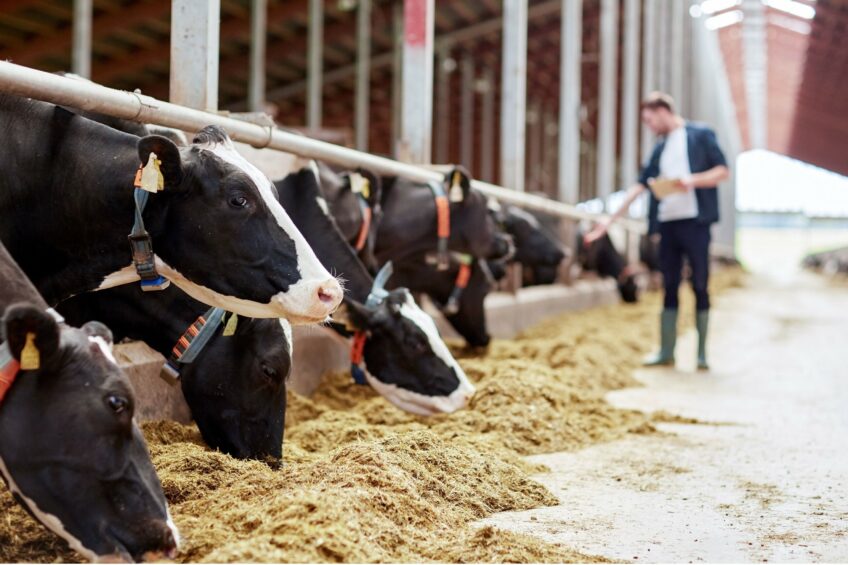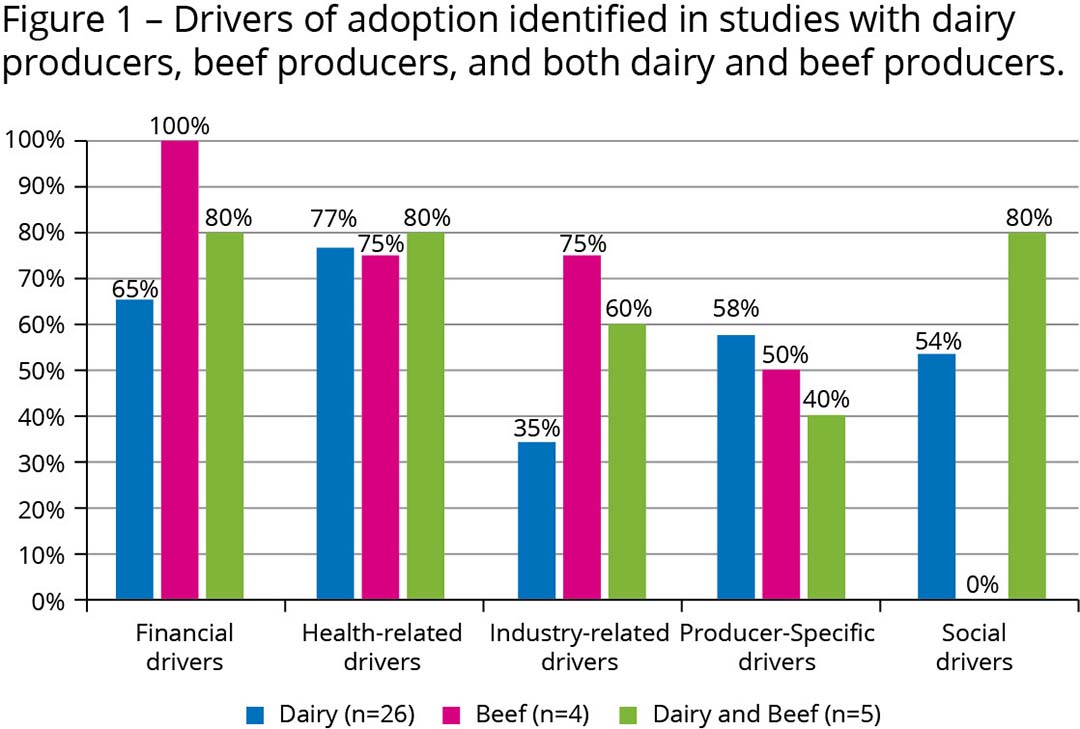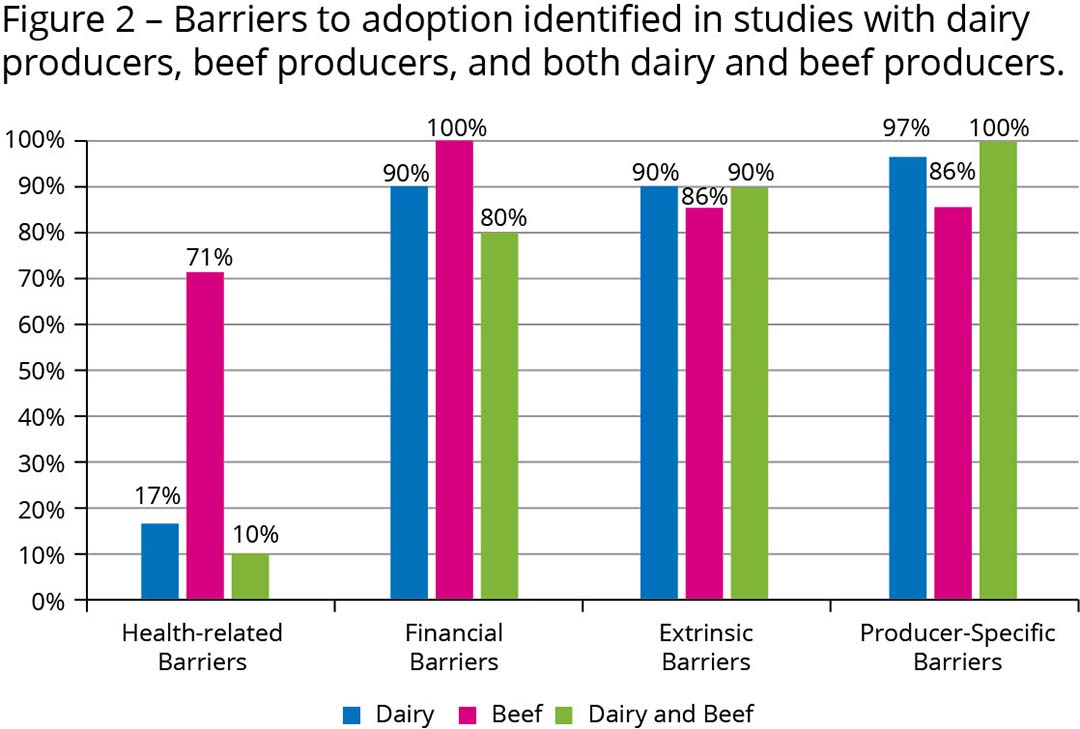Drivers and barriers in disease control and welfare in dairy

Research shows the economic impact and the importance of biosecurity and welfare practices in preventing and reducing the spread of diseases. However, successfully implementing biosecurity measures is lacking in both dairy and beef cattle production. In this report, researchers identify the main drivers and barriers to adopting disease control or welfare practices, highlighting keys that can unlock barriers.
As we all know, implementing disease control and welfare practices is an essential part of limiting disease exposure in livestock. However, successfully adopting these practices by farmers seems to be low. To design farmer-attractive biosecurity strategies, it is crucial to know what drives their decisions in adopting and implementing disease control and welfare practices.
The World Organization for Animal Health refers to biosecurity as “a set of management and physical measures designed to reduce the risk of introduction, establishment and spread of animal diseases, infections or infestations to, from and within an animal population”. Indeed, understanding the drivers and barriers that influence producers’ perceptions towards various disease control and welfare practices may be essential to understanding how to promote increased adoption of these practices, as knowledge is not necessarily the sole driver of change.
Motivations and barriers to adopting biosecurity
In this recently published study, researchers from the University of Calgary, Canada, used primary research articles, dating from 2010 to 2022, to understand the drivers and barriers that cattle producers perceived regarding the implementation of various disease control and welfare practices. Any practice aimed at controlling or preventing disease was considered, including but not limited to vaccinations, biosecurity measures, and participation in disease control programmes. Besides beef cattle, most of the studies focused solely on dairy producers’ perceptions.
Drivers of adoption
The main drivers of disease control and welfare implementation identified were as follows:
- Health-related drivers
- Financial drivers
- Producer-specific drivers
- Social drivers
- Industry-related drivers.
Health-related drivers were most frequently identified within the studies analysed. These included promoting animal health, welfare, and safety, disease prevention, ensuring staff health and safety, as well as producers’ concerns regarding public health. The second most identified driver was financial. This theme included the affordability of practice, financial gains and avoiding losses, impacts on productivity and production losses, savings through future cost reductions and the implemented financial incentives and penalties.
Producer-specific drivers included feelings such as satisfaction or pride, personal experiences, producers’ perceived sense of responsibility, producers’ perceived risk of a disease or need for implementation of a practice, and the perceived effectiveness, feasibility, and convenience of a practice.
Social drivers included veterinary advice, public and consumer perceptions, and social influences such as adoption by other producers. Industry-related drivers included government and industry regulations, market access or demand, and food safety and production quality.
 When categorised by commodity (Figure 1), health-related drivers were identified in 80% of studies including both beef and dairy producers, 77% of studies with only dairy producers, and 75% of studies with only beef. Financial drivers were mentioned most frequently in studies with only beef producers (100%), followed by studies with both beef and dairy producers (80%), and 65% of studies with only dairy.
When categorised by commodity (Figure 1), health-related drivers were identified in 80% of studies including both beef and dairy producers, 77% of studies with only dairy producers, and 75% of studies with only beef. Financial drivers were mentioned most frequently in studies with only beef producers (100%), followed by studies with both beef and dairy producers (80%), and 65% of studies with only dairy.Barriers to adoption
The following 4 barriers to adopting disease control and welfare practices were identified:
- Producer-specific barriers
- Extrinsic barriers
- Financial barriers
- Health-related barriers
The barriers identified most frequently were producer-specific barriers which included the perceived risk of a disease or need for implementing a given practice, perceived effectiveness of a practice, lack of awareness or knowledge, feasibility of implementing a practice, lack of motivation, and producers’ lack of sense of responsibility to adopt a given practice.
 In terms of differences in commodities (Figure 2), producer-specific barriers were most frequently identified in studies with both beef and dairy producers (100%), followed by studies with only dairy producers (97%), and studies with only beef producers (86%).
In terms of differences in commodities (Figure 2), producer-specific barriers were most frequently identified in studies with both beef and dairy producers (100%), followed by studies with only dairy producers (97%), and studies with only beef producers (86%).
Improving communication between vets and farmers
In their study published in the Journal of Dairy Science, researchers found that measuring non-verbal communication (in addition to common verbal communication) between vets and farmers during routine herd health consultations, is key to unlocking barriers for adopting biosecurity measures.
In their study, researchers used video recordings of routine consultations to measure farmer and vet non-verbal communication (NVC). They measured 12 NVC attributes, including body orientation, interpersonal distance, head position, and body lean, which have been shown to influence empathy, rapport, and trust: key components of relationship-centred communication.
It was concluded: “Future research should seek to establish the significance of non-verbal communication in effective communication between vets and farmers, building on our findings that show it is possible to measure non-verbal attributes. Vets may benefit from becoming skilled non-verbal communicators and having more effective conversations during routine consultations, motivating farmers to make changes and improve herd health.”
Case studies as model to influence farmers’ decisions
In another recent study, researchers evaluated the use of case studies as a model to promote the farmer’s confidence and communication in treatment decisions for dairy cattle. They found that using case studies is viewed positively by livestock keepers and allows co-workers to engage in discussions and apply prior knowledge when making treatment decisions. In this study, farmers specifically mentioned that evaluating case studies as a mechanism to help them prepare for future scenarios they may encounter at work would be helpful.
It was therefore concluded that robust training methods, such as case study discussions, can foster skills in dairy workers which then prepare them to make important treatment decisions for animals and could be considered for a variety of topics.
“Future research should evaluate how the on-farm role, for example, manager vs livestock keeper, experience, and other demographic factors such as age and gender may influence perceptions of this type of training,” the researchers noted.
Conclusion
It was concluded that differences in barriers and drivers in the different commodity groups help inform industry initiatives for disease control strategies to be more targeted and ultimately be more effective. This should stimulate more research on how differences in industry practices and management affect drivers and barriers.
Financial support, targeted education, and promoting engagement or communication will help encourage dairy producers to adopt biosecurity measures, while government and industry collaboration with producers may help to develop more effective biosecurity and disease control programmes. Gaining a better understanding of the level of influence these factors have, as well as how the drivers and barriers relate to each other, is essential to increasing the adoption rate of biosecurity practices.
Join 13,000+ subscribers
Subscribe to our newsletter to stay updated about all the need-to-know content in the dairy sector, two times a week.










